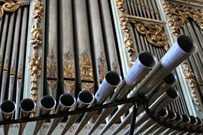The old organ of Nuestra Señora de los Remedios in Estremera (Madrid)
 It is one of the oldest organs that are preserved in the churches of Madrid. It was built in 1716 by one of the most famous organ builders of the Baroque era: Pedro de Liborna Echevarría An organ builder who was part of an established family tradition, he built the most important organs of the Spanish cathedrals beginning of the eighteenth century, such as those of Toledo, Cordoba and Segovia. In the area of Madrid he created the organ of the Basilica of San Lorenzo de El Escorial. Pedro de Liborna was immediately called and appointed by the monarchs as the organ builder of the Royal Chapel. His sons continued in the same office.. It is certainly strange to find an organ manufactured by the official organ manufacturer of the Royal Chapel of the King of Spain in EstremeraEstremera is a small town in the Comunidad de Madrid, located on the border with the Comunidad Autónoma de Castilla-La Mancha., probably the only made outside of the context of the court or outside of the scope of the cathedral.
It is one of the oldest organs that are preserved in the churches of Madrid. It was built in 1716 by one of the most famous organ builders of the Baroque era: Pedro de Liborna Echevarría An organ builder who was part of an established family tradition, he built the most important organs of the Spanish cathedrals beginning of the eighteenth century, such as those of Toledo, Cordoba and Segovia. In the area of Madrid he created the organ of the Basilica of San Lorenzo de El Escorial. Pedro de Liborna was immediately called and appointed by the monarchs as the organ builder of the Royal Chapel. His sons continued in the same office.. It is certainly strange to find an organ manufactured by the official organ manufacturer of the Royal Chapel of the King of Spain in EstremeraEstremera is a small town in the Comunidad de Madrid, located on the border with the Comunidad Autónoma de Castilla-La Mancha., probably the only made outside of the context of the court or outside of the scope of the cathedral.
Although it was built in the eighteenth century, the form and structure are identical to those of the organs from the previous century (photo 1). The cabinet has three façades and is made of pine wood, inlaid with polychrome decoration. It consists of two parts: a base with the window of the consoleThe organist’s place, where the keyboard is with a keyboard in bone and ebony, tiradoresThe tiradores are knobs that control the different registers, positioned to the side of the keyboard. on both sides of the keyboard and the knee pad below the keyboard. Above the console there is a second body, with the frieze of horns, and, higher up, five windows with castillosThe term refers to the way to place the pipes in the windows of the cabinet, always in a geometric way and in symmetry. They are reminiscent of the towers of castles., with pipes decorated with gargoyles, the mouths of which emit sounds (photo 2). In this second body on the left side, note the figure of a angelito leaning on a snake. A very interesting element of this Baroque instrument is the bellows positioned behind the structure, an original piece to which a more modern system of turbo ventilation was added.
 In 1994, the organ was restored respecting the original features, although it was necessary to rebuild a good number of rods that had been lost. Today it continues to work, as most of the Baroque organs that have been described in this itinerary.
In 1994, the organ was restored respecting the original features, although it was necessary to rebuild a good number of rods that had been lost. Today it continues to work, as most of the Baroque organs that have been described in this itinerary.
